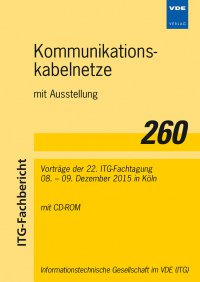A combinatorial heuristic algorithm supporting computer-aided planning of optical fiber networks
Konferenz: Kommunikationskabelnetze mit Ausstellung - 22. ITG-Fachtagung
08.12.2015 - 09.12.2015 in Köln, Deutschland
Tagungsband: Kommunikationskabelnetze mit Ausstellung
Seiten: 9Sprache: EnglischTyp: PDF
Persönliche VDE-Mitglieder erhalten auf diesen Artikel 10% Rabatt
Autoren:
Wiggenbrock, Jens (South Westphalia University of Applied Sciences, Engineering and Economic Sciences, Lindenstr. 53, 59872 Meschede, Germany)
Dragos, Kosmas; Smarsly, Kay (Bauhaus University Weimar, Chair of Computing in Civil Engineering, Coudraystr. 7, 99423 Weimar, Germany)
Inhalt:
Infrastructure systems form the backbone of modern society. The increasing need for fast and reliable data exchange fosters the development of new high-speed optical fiber networks. However, building new infrastructure systems is very expensive; the building cost for optical fiber networks is determined by the cost for cabling and by the cost for trenching. Computer-aided planning aims to reduce the building cost by calculating the optimum paths for optical fiber networks. Common approaches towards computer-aided planning of optical fiber networks are based on the algorithms of Prim and Dijkstra. Each algorithm, as will be illustrated in this paper, is designed to address one single objective – i.e. one cost factor (cabling or trenching). Computer-aided planning, however, requires holistic algorithms taking into account all cost factors to achieve minimum total cost. This paper investigates the performance of a combinatorial heuristic algorithm for computer-aided planning of optical fiber networks. The algorithm is validated using digital map data of an existing residential area. In summary, the proposed approach, as compared to traditional approaches, results in reduced building cost for optical fiber networks. In this study, cost reductions up to 23% have been achieved.


